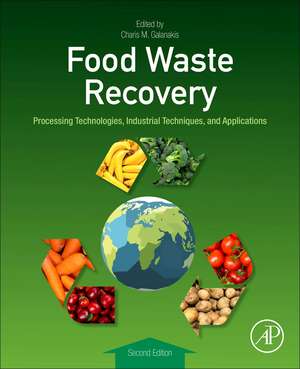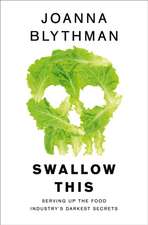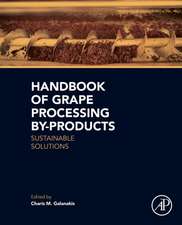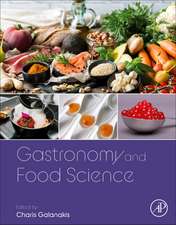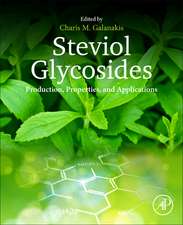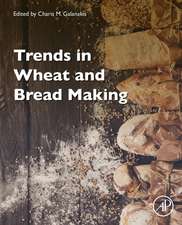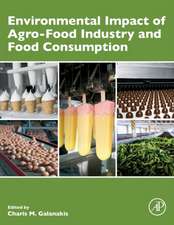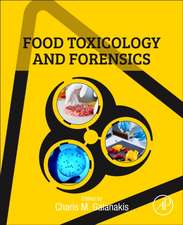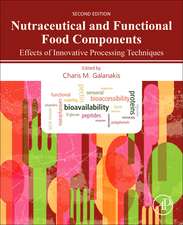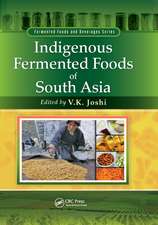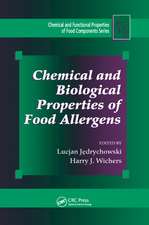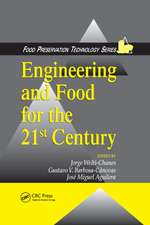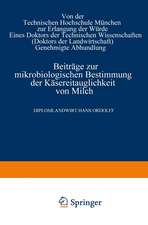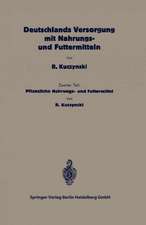Food Waste Recovery: Processing Technologies, Industrial Techniques, and Applications
Editat de Charis M. Galanakisen Limba Engleză Paperback – 7 dec 2020
- Covers food waste management within the food industry by developing recovery strategies
- Provides coverage of processing technologies and industrial techniques for the recovery of valuable compounds from food processing by-products
- Explores the different applications of compounds recovered from food processing using three approaches: targeting by-products, targeting ingredients, and targeting bioactive applications
| Toate formatele și edițiile | Preț | Express |
|---|---|---|
| Paperback (1) | 765.72 lei 36-50 zile | |
| ELSEVIER SCIENCE – 7 dec 2020 | 765.72 lei 36-50 zile | |
| Hardback (1) | 566.56 lei 36-50 zile | |
| ELSEVIER SCIENCE – 21 iul 2015 | 566.56 lei 36-50 zile |
Preț: 765.72 lei
Preț vechi: 977.85 lei
-22% Nou
Puncte Express: 1149
Preț estimativ în valută:
146.57€ • 159.26$ • 123.20£
146.57€ • 159.26$ • 123.20£
Carte tipărită la comandă
Livrare economică 14-28 aprilie
Preluare comenzi: 021 569.72.76
Specificații
ISBN-13: 9780128205631
ISBN-10: 0128205636
Pagini: 560
Ilustrații: Approx. 110 illustrations
Dimensiuni: 216 x 276 mm
Greutate: 1.28 kg
Ediția:2
Editura: ELSEVIER SCIENCE
ISBN-10: 0128205636
Pagini: 560
Ilustrații: Approx. 110 illustrations
Dimensiuni: 216 x 276 mm
Greutate: 1.28 kg
Ediția:2
Editura: ELSEVIER SCIENCE
Cuprins
Part I: Introduction
1. Food waste management, valorization, and sustainability in the food industry
2. Classification and target compounds
3. The universal recovery strategy
Part II: Conventional Techniques
4. Conventional macroscopic pretreatment
5. Conventional macro and micromolecules separation
6. Conventional extraction
7. Conventional purification and isolation
8. Conventional Product formation
Part III: Emerging Technologies
9. Emerging Macroscopic Pre-treatment
10. Emerging Macro- and micro-molecules separation
11. Emerging Extraction
12. Emerging Purification and isolation
13. Emerging Product formation
Part IV: Commercialized aspects and applications
14. Cost and safety issues of emerging technologies against conventional techniques
15. Recovery and applications of enzymes from food wastes
16. Applications of compounds recovered from olive mill waste
17. Application of compounds from grape processing by-products: Formulation of dietary fibre and encapsuled bioactive compounds
18. Plant-based by-products
19. Applications in bakery products
20. Valorization of meat by-products
21. Potential applications of food industrial by-products in the dairy industry
22. Antimicrobial compounds improve food shelf-life
23. Foods and supplements
24. Cosmetics
1. Food waste management, valorization, and sustainability in the food industry
2. Classification and target compounds
3. The universal recovery strategy
Part II: Conventional Techniques
4. Conventional macroscopic pretreatment
5. Conventional macro and micromolecules separation
6. Conventional extraction
7. Conventional purification and isolation
8. Conventional Product formation
Part III: Emerging Technologies
9. Emerging Macroscopic Pre-treatment
10. Emerging Macro- and micro-molecules separation
11. Emerging Extraction
12. Emerging Purification and isolation
13. Emerging Product formation
Part IV: Commercialized aspects and applications
14. Cost and safety issues of emerging technologies against conventional techniques
15. Recovery and applications of enzymes from food wastes
16. Applications of compounds recovered from olive mill waste
17. Application of compounds from grape processing by-products: Formulation of dietary fibre and encapsuled bioactive compounds
18. Plant-based by-products
19. Applications in bakery products
20. Valorization of meat by-products
21. Potential applications of food industrial by-products in the dairy industry
22. Antimicrobial compounds improve food shelf-life
23. Foods and supplements
24. Cosmetics
Recenzii
"This is a “must-have book and should be used in every food science curriculum. This book would also be an excellent reference book for companies in the food industry or even the food value chain, from primary production through to the retail sector." --FST Magazine
